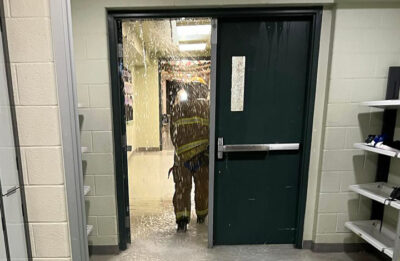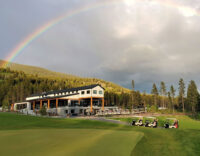Cold temperatures creating chaos on infrastructure
By Alejandra Pulido-Guzman - Lethbridge Herald on January 17, 2024.
 Holy Spirit Catholic School Division photo -
Emergency personnel respond to a waterline break on Friday at Father Leonard Van Tighem School.
Holy Spirit Catholic School Division photo -
Emergency personnel respond to a waterline break on Friday at Father Leonard Van Tighem School.LETHBRIDGE HERALDapulido@lethbridgeherald.com
With multiple buildings across the city dealing with the aftermath of extreme cold temperatures earlier this week, where many had to shut down due to pipes bursting, the Herald reached out to a Civil Engineering Technology instructor at Lethbridge College to find out why.
Doug May, who teaches Infrastructure Design among other courses, spoke to the Herald on Tuesday about some of the reasons behind the chaos caused by extreme low temperatures on pipes.
He said even though the pipes that burst inside multiple buildings across the city were indoors, problems comes from sections of pipes that are outdoors.
“For water pipes that are on exterior walls the insulation is only rated to a certain temperature, and with the temperature we have had ranging between -35 and -37 degrees for a prolong period of time, that cold it’s going to eventually find its way in through the wall and will freeze,” said May.
He said in part this is happening because of a massive temperature differential that has made it nearly impossible for furnaces and boilers to keep up.
“When you have your thermostat set at 20°C and it’s -37°C outside, that’s 57 degrees differential between inside and outside, that cold is going to work its way in,” said May.
He said water is always in pipes and when the temperatures drop significantly that can cause the stagnant water to freeze, making its way through insulation until reaching the indoor pipes. And once the ice melts because of the temperature differential can cause a pressure increase that will result in pipes bursting.
“When ice expands, and melts as a result, it expands at an enormous pressure, around probably 30,000 pounds per square inch of pressure, so that’s an enormous amount of pressure and that’s why pipes are bursting,” said May.
He said one way to prevent water from freezing inside the pipes is by letting it flow. Even a small continous drip would help in an extreme temperature situation.
“What we used to do in Newfoundland was we kept the water running just a little bit, just a little dribble of water to keep the water circulating in the system, because you as soon as water is turned off and it’s left stagnant that’s when you run the risk of it freezing,” said May.
He explained this could be something to keep in mind, especially with indoor plumbing that comes from an external wall.
“If you have a bathroom in a school where water is on the exterior wall that’s a risk, in a residence it’s a risk. Normally the building code demands that all piping be on interior walls, when it’s moving it’s channeled through the pipe that’s in the interior wall,” said May.
He said that even though it is difficult to know what temperature to keep a building at to avoid problems, as that is dictated by the building design, it is advised to keep the temperature constant.
“When the temperature is dialed down in buildings when they have lower use to conserve energy, like in schools over the weekend for example, that could be a contributing factor,” said May.
16-15




